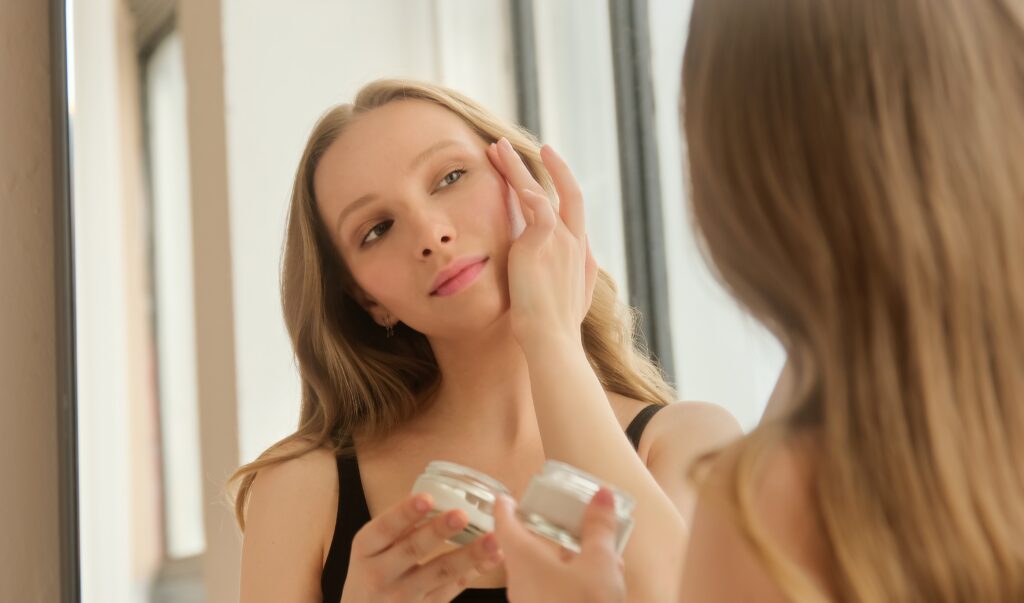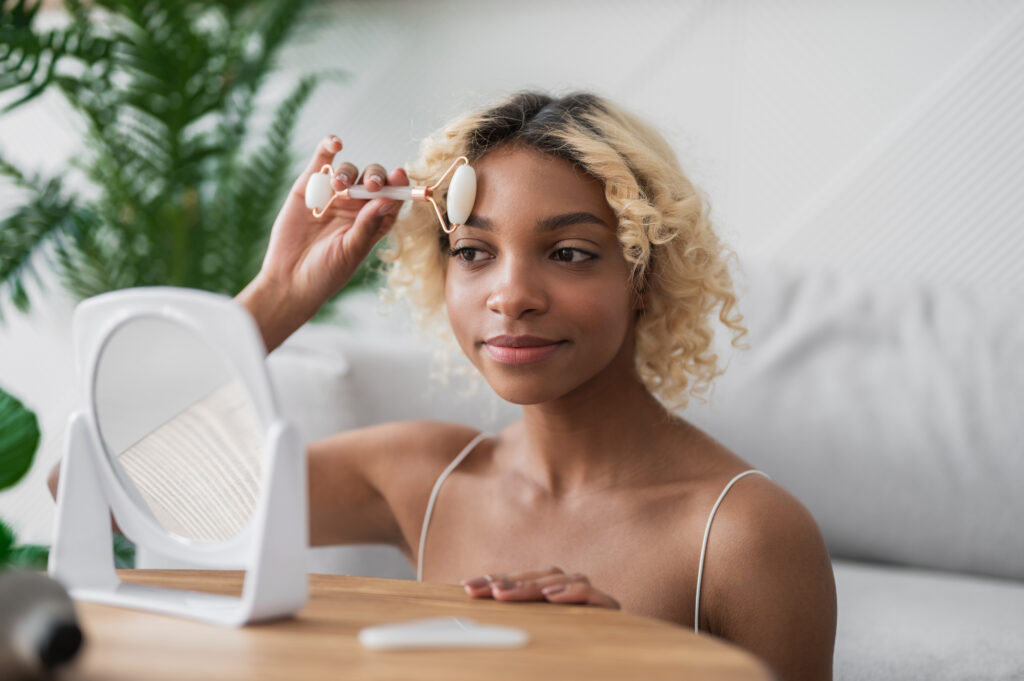
Maintaining a daily face care routine is essential to promoting healthy, radiant skin.
It involves a series of practices and habits that contribute to skin care and overall well-being. Caring for your face also includes paying attention to your skin type and concerns, whether dry, oily or sensitive. Creating a consistent routine allows the skin to breathe, replenish and maintain its natural balance. It is also beneficial to combine exfoliation and use facial masks to remove dead skin cells and provide deep nourishment. By devoting time and effort to a daily facial routine, you can achieve healthy, glowing skin that radiates confidence and well-being.
The Perfect Skincare Routine for Your Skin Type
There are five common skin types: normal, dry, oily, combination, and sensitive. Understanding your skin type is very important to developing the perfect skincare routine tailored to your specific needs. Normal skin is well-balanced and requires a routine that focuses on maintaining its natural harmony.
Dry skin needs extra hydration and nourishment to combat flakiness and tightness. Oily skin benefits from products that regulate sebum production and keep shine at bay, while combination skin requires a careful balance to address both oily and dry areas. Sensitive skin is delicate and prone to irritation, necessitating gentle, fragrance-free products.
Regardless of your skin type, a comprehensive routine typically involves cleansing to remove impurities, followed by toning to restore pH balance and moisturizing to hydrate and protect the skin. Additionally, incorporating serums, exfoliators, and face masks specific to your skin’s needs can provide additional benefits. Regularly assessing your skin and adjusting your routine accordingly ensures that you give your skin the care it deserves, resulting in a healthier, more radiant complexion.

The Essential Steps of Face Care at Home
Cleansing
Cleansing your face is vital for maintaining healthy and radiant skin. Daily exposure to environmental pollutants, sweat, and excess oil can clog pores and lead to various skin issues. By incorporating a gentle facial cleanser into your routine, you can effectively remove these impurities and revitalize your skin.
When choosing a facial cleanser, consider your skin type and concerns. Dry or sensitive skin benefits from a mild and hydrating cleanser, while those with oily or acne-prone skin may need a cleanser that targets excess oil and unclogs pores. Avoid harsh cleansers that strip away natural oils, as they can cause dryness and irritation.
Start dampening your skin with lukewarm water. Apply a small amount of cleanser and gently massage it onto your face using circular motions. Pay attention to areas prone to oiliness, like the T-zone, and don’t forget to cleanse your neck as well.
While massaging the cleanser, take a moment to indulge in a gentle facial massage. This stimulates blood circulation, promotes lymphatic drainage, and relaxes facial muscles. Use upward motions to counteract gravity and encourage a lifted appearance.
After thoroughly massaging the cleanser, rinse it off with lukewarm water. Gently pat your face dry with a clean towel, avoiding rubbing or tugging that can cause irritation.
By making cleansing a consistent part of your routine, you create a clean canvas for other skincare products to penetrate effectively. Cleansing removes dirt and impurities while preparing your skin to absorb the benefits of serums, moisturizers, and treatments. This simple yet vital step helps maintain a healthier complexion, promoting a vibrant and radiant appearance.
Exfoliation
This step involves removing the buildup of dead skin cells, allowing for fresher skin and enhancing the effectiveness of other skin care products. It’s important to choose an exfoliator that suits your skin type and preferences, whether it’s a physical exfoliant with tiny beads or a chemical exfoliator with ingredients like alpha hydroxy acids (AHAs) or beta hydroxy acids (BHAs).
It is recommended to exfoliate 1-2 times a week to avoid over-exfoliation that may cause irritation and sensitivity. Start by moisturizing your skin with water to make it more receptive to the scrub. Take a small amount of the exfoliating product and gently massage it onto your face using gentle circular motions. Pay attention to areas where dead skin cells tend to accumulate, such as the forehead, nose, and chin. Be careful not to apply too much pressure to prevent damaging the skin.
After massaging the scrub on your skin, rinse it well with water. Use lukewarm water to ensure your skin stays balanced and to avoid excessive dryness. Dry your face with a clean towel, being careful not to scrub too harshly, as newly exfoliated skin may be more sensitive. Remember to choose a scrub suitable for your skin type, exfoliate sparingly, and always be gentle to avoid irritation. With consistent and proper exfoliation, you can enjoy the benefits of healthier, more vibrant skin.
Moisturizing for Face Care
After the cleansing and exfoliation steps, it is crucial to restore moisture to the skin by using an appropriate moisturizer. Moisturizers play a vital role in hydrating the skin, enhancing its elasticity, and forming a protective barrier against environmental stressors. To choose the right moisturizer, consider your skin type and preferences. Opt for a lightweight lotion, a nourishing cream, or a refreshing gel formula that suits your specific needs.
Once you have selected a suitable moisturizer, take a small amount and gently massage it into your skin using your fingertips. Start by applying it to your face, using upward motions to promote circulation and absorption. Extend the application to your neck and décolletage as well, as these areas are often overlooked but require moisture and care too.
When applying the moisturizer, focus on areas that tend to be drier or require extra attention, such as the cheeks or areas prone to fine lines. Take the time to enjoy the soothing sensation and let the moisturizer fully absorb into your skin.
Remember, moisturizing is not limited to just the face. It is equally important to apply moisturizer to other parts of your body that may need hydration, such as your hands, elbows, and knees. This comprehensive approach ensures that your skin remains nourished and supple from head to toe.
By including moisturizing as a regular step in your skincare routine, you provide your skin with the essential hydration it needs to maintain a healthy and youthful appearance. Moisturizers not only replenish moisture but also lock it in, preventing water loss and protecting your skin from external factors. So, pamper your skin with a suitable moisturizer and enjoy the benefits of a hydrated, radiant complexion.
Face masks and treatments
Face masks and treatments are valuable additions to your skincare routine, offering targeted care to address specific skin concerns. To incorporate masks and treatments into your routine, begin with clean and dry skin. This ensures optimal absorption of the beneficial ingredients. Apply a generous layer of the mask or treatment to your face, avoiding the delicate eye area. You can use a brush, spatula, or your fingertips to evenly distribute the product across your skin.
Once applied, allow the mask or treatment to work its magic for the recommended time duration. This timeframe allows the potent ingredients to penetrate the skin and deliver their targeted benefits. Relax and enjoy this indulgent self-care moment while the mask or treatment does its job.
After the specified time has passed, it’s time to rinse off or remove the product according to the instructions provided. Some masks may require rinsing with warm water, while others can be gently wiped away with a damp cloth. Be sure to follow the specific guidelines to ensure the best results.
To optimize the effectiveness of masks and treatments, incorporate them into your routine 1-2 times a week. This frequency allows for regular and consistent skincare maintenance while preventing potential overuse.
By adding face masks and treatments to your regimen, you can provide your skin with targeted care and address specific concerns. Embrace the versatility of masks and treatments, and discover a personalized skincare experience that helps you achieve a healthy and radiant complexion.
The Significance of BB Cream in Your Beauty Arsenal
BB cream, also known as beauty balm or blemish balm, has emerged as a multitasking product that has revolutionized the world of cosmetics. Its importance lies in its ability to deliver multiple benefits in a single formula. Acting as a lightweight foundation, BB cream provides coverage that evens out skin tone and conceals imperfections, granting a natural and radiant finish. Beyond its cosmetic prowess, BB cream offers additional advantages, such as moisturizing properties that hydrate the skin, leaving it supple and plump.
Furthermore, many BB creams contain built-in sun protection, safeguarding the skin from harmful UV rays, which helps prevent premature aging and sun damage. Additionally, some formulations incorporate skincare ingredients like antioxidants, vitamins, and botanical extracts, providing nourishment and improving the overall health of the skin. The versatility and convenience of BB cream make it an indispensable tool for those seeking a simplified beauty routine without compromising on a flawless complexion. By embracing the benefits of BB cream, you can enjoy a natural-looking glow while simultaneously enhancing and protecting your skin.

FAQ
To determine your skin type, observe how your skin behaves throughout the day. Generally, there are four main skin types: oily, dry, combination, and normal. Oily skin tends to have excess sebum production, dry skin lacks moisture, combination skin has both oily and dry areas, and normal skin is well-balanced.
It is recommended to cleanse your face twice daily, once in the morning and once before bed.
Yes, moisturizing is essential for all skin types as it helps maintain hydration and protect the skin’s barrier.
Facial masks can be used 1-2 times a week, depending on your skin’s needs and the type of mask.
Exfoliation helps remove dead skin cells and promotes a smoother complexion. However, it should be done in moderation to avoid over-exfoliation. Depending on your skin type, it is generally recommended to exfoliate 1-2 times per week using a gentle exfoliator suitable for your skin.
Sunscreen is a crucial step in any face care routine as it protects the skin from harmful UV rays that can lead to sunburn, premature aging, and skin cancer. It is recommended to use a broad-spectrum sunscreen with at least SPF 30 and to reapply every two hours, especially when exposed to the sun.

